Supporting Independent Living: The Role of Technology in Healthcare
VerifiedAdded on 2024/06/25
|20
|5552
|175
Essay
AI Summary
This essay examines the role of technology in supporting independent living for users of health and social care services, focusing on the benefits, barriers, health and safety considerations, and ethical implications. It analyzes how assistive technologies like eye patches, adapted keyboards, and mobility aids enable individuals with conditions like multiple sclerosis to maintain independence. The essay also addresses challenges such as the cost and accessibility of technology, the importance of proper training, and potential long-term implications for users. Furthermore, it discusses the impact of technological advancements on healthcare organizations and care workers, emphasizing the need for ethical considerations and adherence to health and safety regulations. The essay concludes with recommendations for leveraging technology to support independent living arrangements and evaluates the overall usefulness of technology in enhancing the quality of life for individuals requiring healthcare support.

Supporting Independent Living
1
1
Paraphrase This Document
Need a fresh take? Get an instant paraphrase of this document with our AI Paraphraser
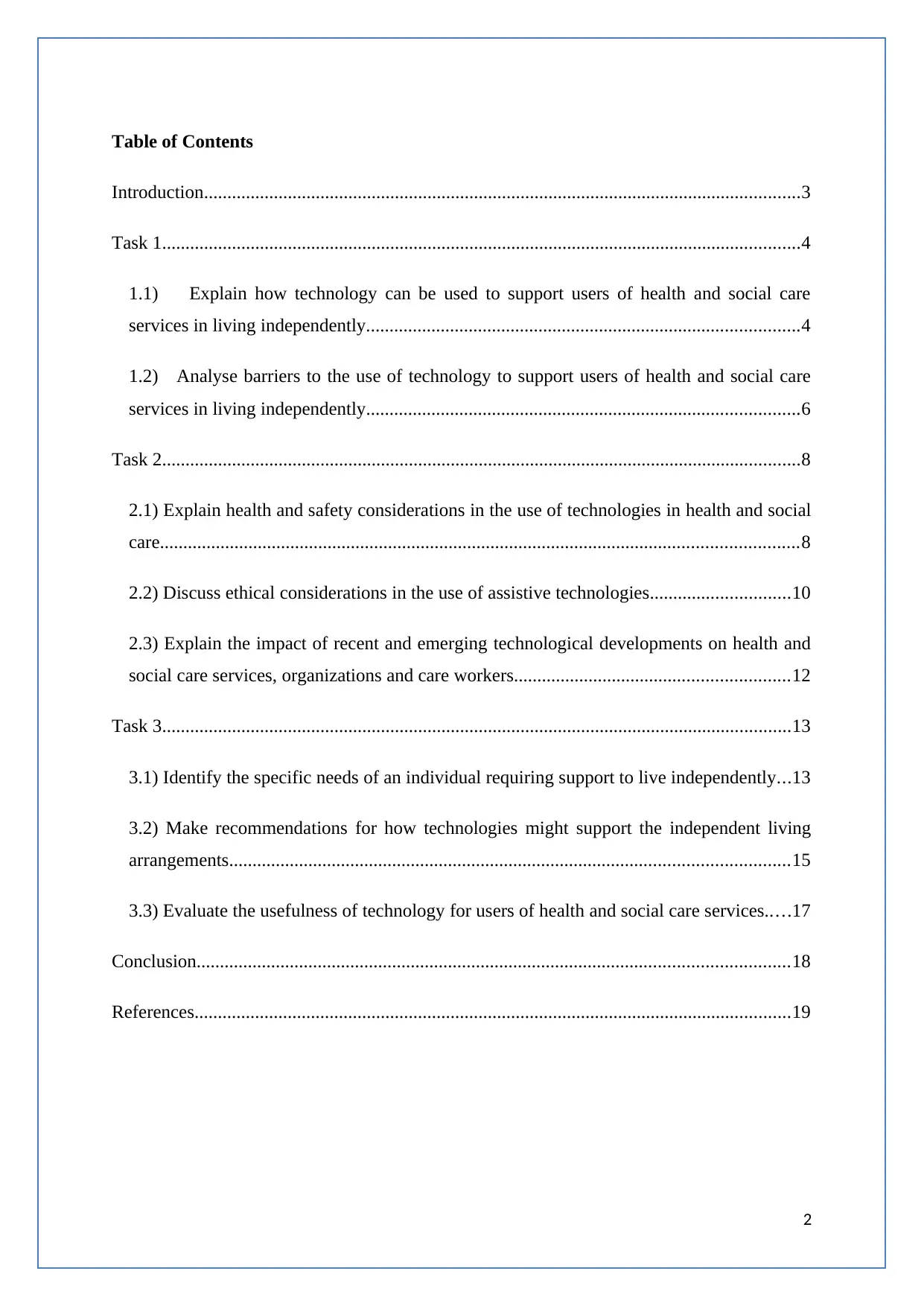
Table of Contents
Introduction................................................................................................................................3
Task 1.........................................................................................................................................4
1.1) Explain how technology can be used to support users of health and social care
services in living independently.............................................................................................4
1.2) Analyse barriers to the use of technology to support users of health and social care
services in living independently.............................................................................................6
Task 2.........................................................................................................................................8
2.1) Explain health and safety considerations in the use of technologies in health and social
care.........................................................................................................................................8
2.2) Discuss ethical considerations in the use of assistive technologies..............................10
2.3) Explain the impact of recent and emerging technological developments on health and
social care services, organizations and care workers...........................................................12
Task 3.......................................................................................................................................13
3.1) Identify the specific needs of an individual requiring support to live independently...13
3.2) Make recommendations for how technologies might support the independent living
arrangements........................................................................................................................15
3.3) Evaluate the usefulness of technology for users of health and social care services.....17
Conclusion...............................................................................................................................18
References................................................................................................................................19
2
Introduction................................................................................................................................3
Task 1.........................................................................................................................................4
1.1) Explain how technology can be used to support users of health and social care
services in living independently.............................................................................................4
1.2) Analyse barriers to the use of technology to support users of health and social care
services in living independently.............................................................................................6
Task 2.........................................................................................................................................8
2.1) Explain health and safety considerations in the use of technologies in health and social
care.........................................................................................................................................8
2.2) Discuss ethical considerations in the use of assistive technologies..............................10
2.3) Explain the impact of recent and emerging technological developments on health and
social care services, organizations and care workers...........................................................12
Task 3.......................................................................................................................................13
3.1) Identify the specific needs of an individual requiring support to live independently...13
3.2) Make recommendations for how technologies might support the independent living
arrangements........................................................................................................................15
3.3) Evaluate the usefulness of technology for users of health and social care services.....17
Conclusion...............................................................................................................................18
References................................................................................................................................19
2
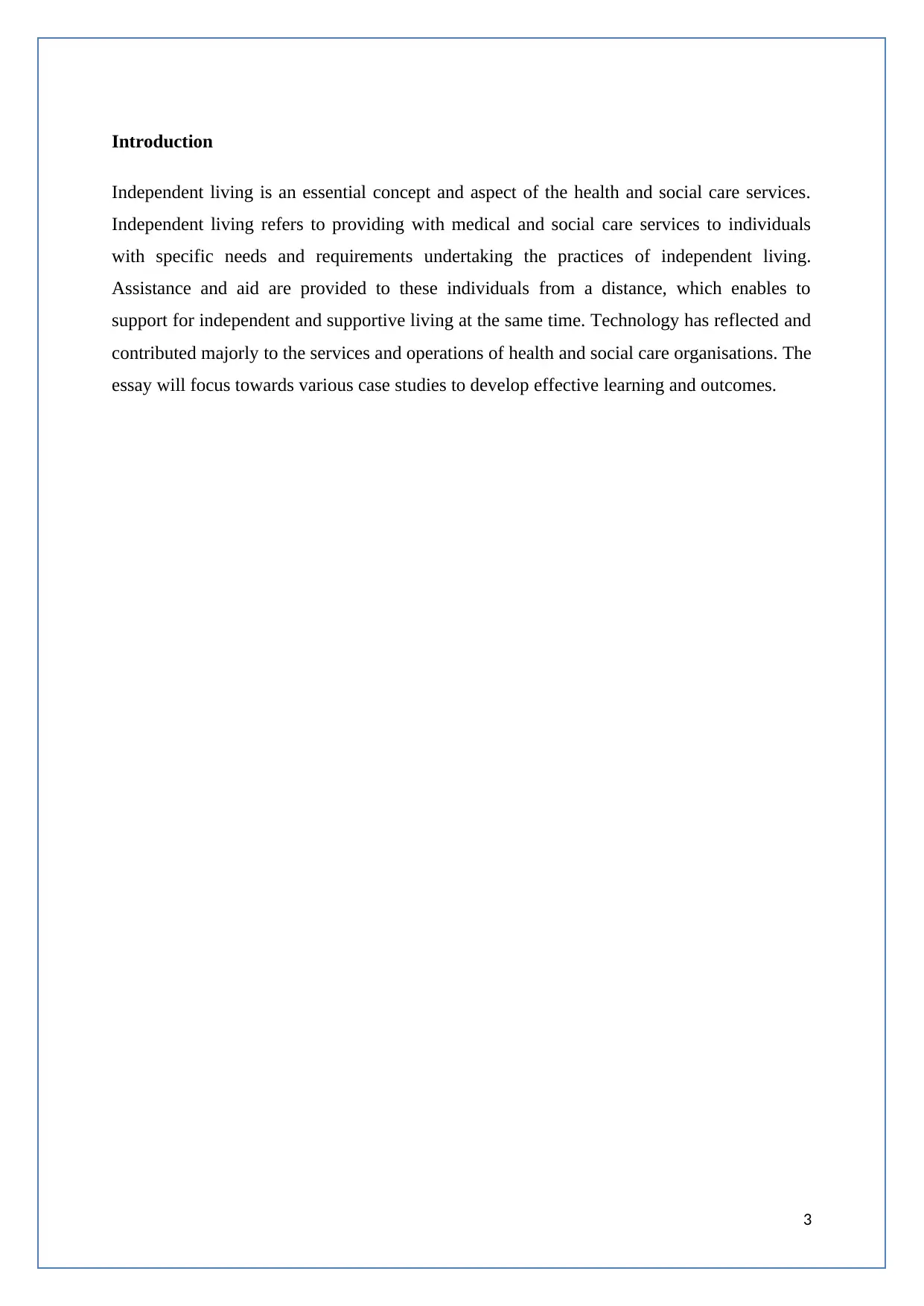
Introduction
Independent living is an essential concept and aspect of the health and social care services.
Independent living refers to providing with medical and social care services to individuals
with specific needs and requirements undertaking the practices of independent living.
Assistance and aid are provided to these individuals from a distance, which enables to
support for independent and supportive living at the same time. Technology has reflected and
contributed majorly to the services and operations of health and social care organisations. The
essay will focus towards various case studies to develop effective learning and outcomes.
3
Independent living is an essential concept and aspect of the health and social care services.
Independent living refers to providing with medical and social care services to individuals
with specific needs and requirements undertaking the practices of independent living.
Assistance and aid are provided to these individuals from a distance, which enables to
support for independent and supportive living at the same time. Technology has reflected and
contributed majorly to the services and operations of health and social care organisations. The
essay will focus towards various case studies to develop effective learning and outcomes.
3
⊘ This is a preview!⊘
Do you want full access?
Subscribe today to unlock all pages.

Trusted by 1+ million students worldwide
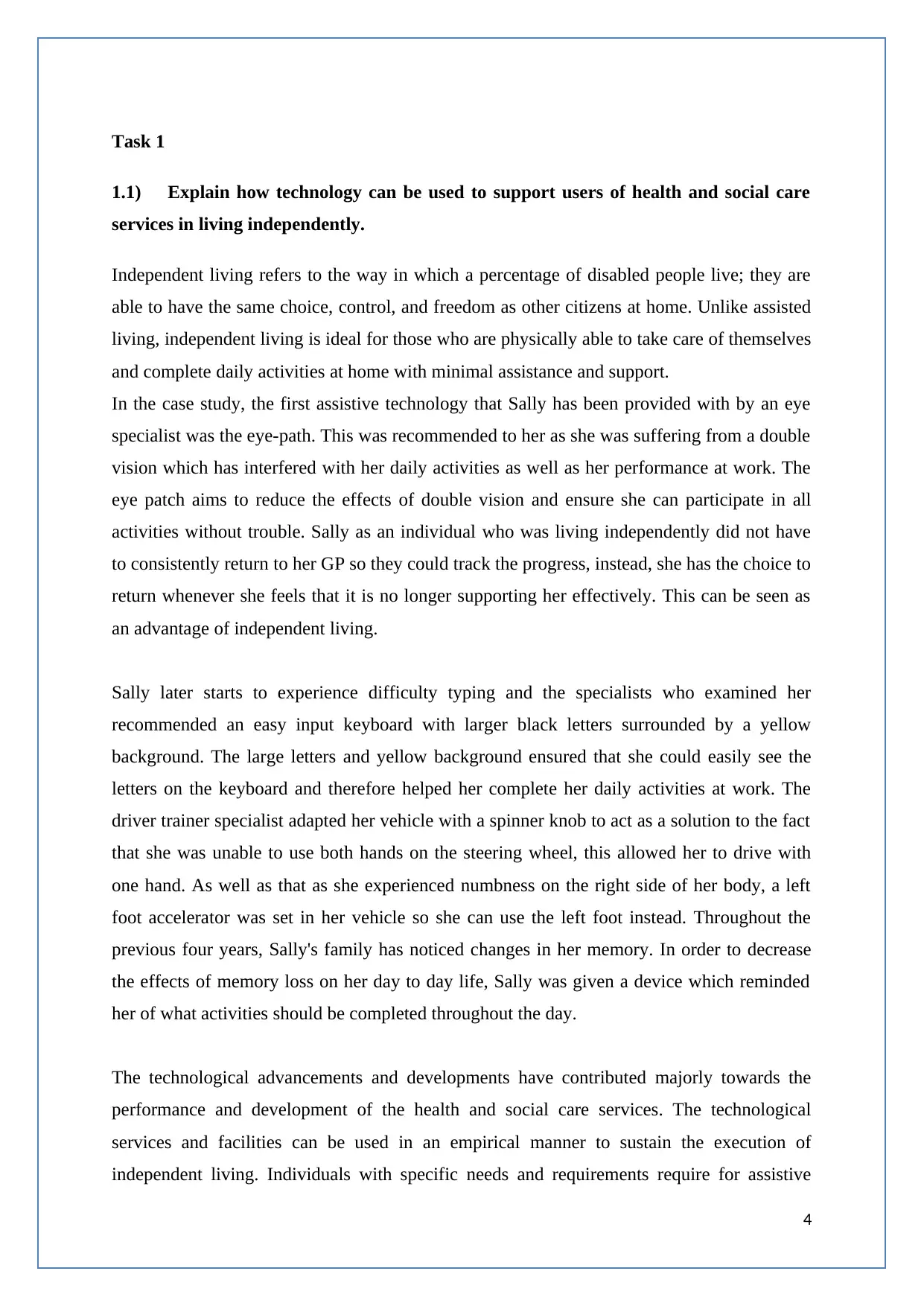
Task 1
1.1) Explain how technology can be used to support users of health and social care
services in living independently.
Independent living refers to the way in which a percentage of disabled people live; they are
able to have the same choice, control, and freedom as other citizens at home. Unlike assisted
living, independent living is ideal for those who are physically able to take care of themselves
and complete daily activities at home with minimal assistance and support.
In the case study, the first assistive technology that Sally has been provided with by an eye
specialist was the eye-path. This was recommended to her as she was suffering from a double
vision which has interfered with her daily activities as well as her performance at work. The
eye patch aims to reduce the effects of double vision and ensure she can participate in all
activities without trouble. Sally as an individual who was living independently did not have
to consistently return to her GP so they could track the progress, instead, she has the choice to
return whenever she feels that it is no longer supporting her effectively. This can be seen as
an advantage of independent living.
Sally later starts to experience difficulty typing and the specialists who examined her
recommended an easy input keyboard with larger black letters surrounded by a yellow
background. The large letters and yellow background ensured that she could easily see the
letters on the keyboard and therefore helped her complete her daily activities at work. The
driver trainer specialist adapted her vehicle with a spinner knob to act as a solution to the fact
that she was unable to use both hands on the steering wheel, this allowed her to drive with
one hand. As well as that as she experienced numbness on the right side of her body, a left
foot accelerator was set in her vehicle so she can use the left foot instead. Throughout the
previous four years, Sally's family has noticed changes in her memory. In order to decrease
the effects of memory loss on her day to day life, Sally was given a device which reminded
her of what activities should be completed throughout the day.
The technological advancements and developments have contributed majorly towards the
performance and development of the health and social care services. The technological
services and facilities can be used in an empirical manner to sustain the execution of
independent living. Individuals with specific needs and requirements require for assistive
4
1.1) Explain how technology can be used to support users of health and social care
services in living independently.
Independent living refers to the way in which a percentage of disabled people live; they are
able to have the same choice, control, and freedom as other citizens at home. Unlike assisted
living, independent living is ideal for those who are physically able to take care of themselves
and complete daily activities at home with minimal assistance and support.
In the case study, the first assistive technology that Sally has been provided with by an eye
specialist was the eye-path. This was recommended to her as she was suffering from a double
vision which has interfered with her daily activities as well as her performance at work. The
eye patch aims to reduce the effects of double vision and ensure she can participate in all
activities without trouble. Sally as an individual who was living independently did not have
to consistently return to her GP so they could track the progress, instead, she has the choice to
return whenever she feels that it is no longer supporting her effectively. This can be seen as
an advantage of independent living.
Sally later starts to experience difficulty typing and the specialists who examined her
recommended an easy input keyboard with larger black letters surrounded by a yellow
background. The large letters and yellow background ensured that she could easily see the
letters on the keyboard and therefore helped her complete her daily activities at work. The
driver trainer specialist adapted her vehicle with a spinner knob to act as a solution to the fact
that she was unable to use both hands on the steering wheel, this allowed her to drive with
one hand. As well as that as she experienced numbness on the right side of her body, a left
foot accelerator was set in her vehicle so she can use the left foot instead. Throughout the
previous four years, Sally's family has noticed changes in her memory. In order to decrease
the effects of memory loss on her day to day life, Sally was given a device which reminded
her of what activities should be completed throughout the day.
The technological advancements and developments have contributed majorly towards the
performance and development of the health and social care services. The technological
services and facilities can be used in an empirical manner to sustain the execution of
independent living. Individuals with specific needs and requirements require for assistive
4
Paraphrase This Document
Need a fresh take? Get an instant paraphrase of this document with our AI Paraphraser
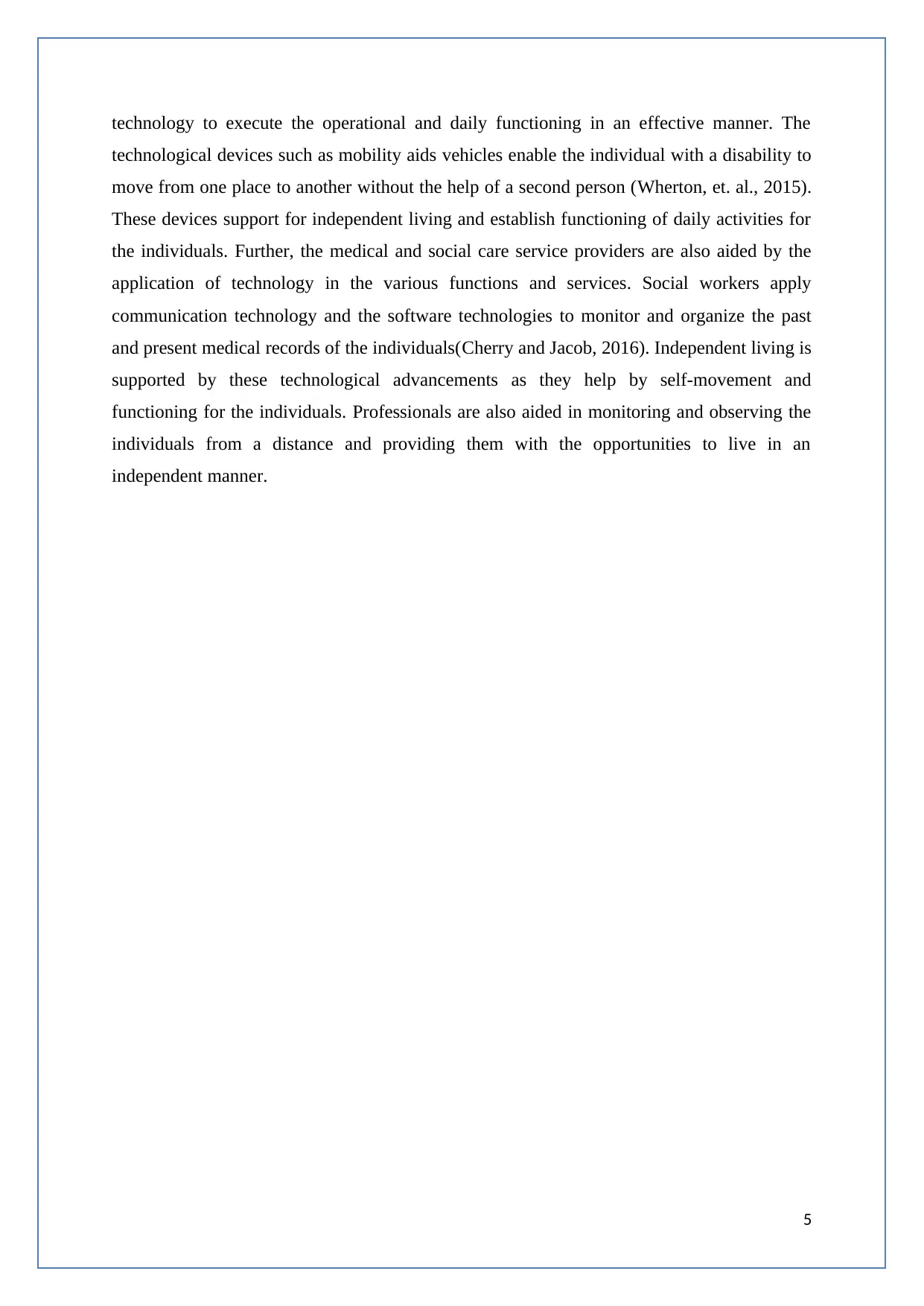
technology to execute the operational and daily functioning in an effective manner. The
technological devices such as mobility aids vehicles enable the individual with a disability to
move from one place to another without the help of a second person (Wherton, et. al., 2015).
These devices support for independent living and establish functioning of daily activities for
the individuals. Further, the medical and social care service providers are also aided by the
application of technology in the various functions and services. Social workers apply
communication technology and the software technologies to monitor and organize the past
and present medical records of the individuals(Cherry and Jacob, 2016). Independent living is
supported by these technological advancements as they help by self-movement and
functioning for the individuals. Professionals are also aided in monitoring and observing the
individuals from a distance and providing them with the opportunities to live in an
independent manner.
5
technological devices such as mobility aids vehicles enable the individual with a disability to
move from one place to another without the help of a second person (Wherton, et. al., 2015).
These devices support for independent living and establish functioning of daily activities for
the individuals. Further, the medical and social care service providers are also aided by the
application of technology in the various functions and services. Social workers apply
communication technology and the software technologies to monitor and organize the past
and present medical records of the individuals(Cherry and Jacob, 2016). Independent living is
supported by these technological advancements as they help by self-movement and
functioning for the individuals. Professionals are also aided in monitoring and observing the
individuals from a distance and providing them with the opportunities to live in an
independent manner.
5
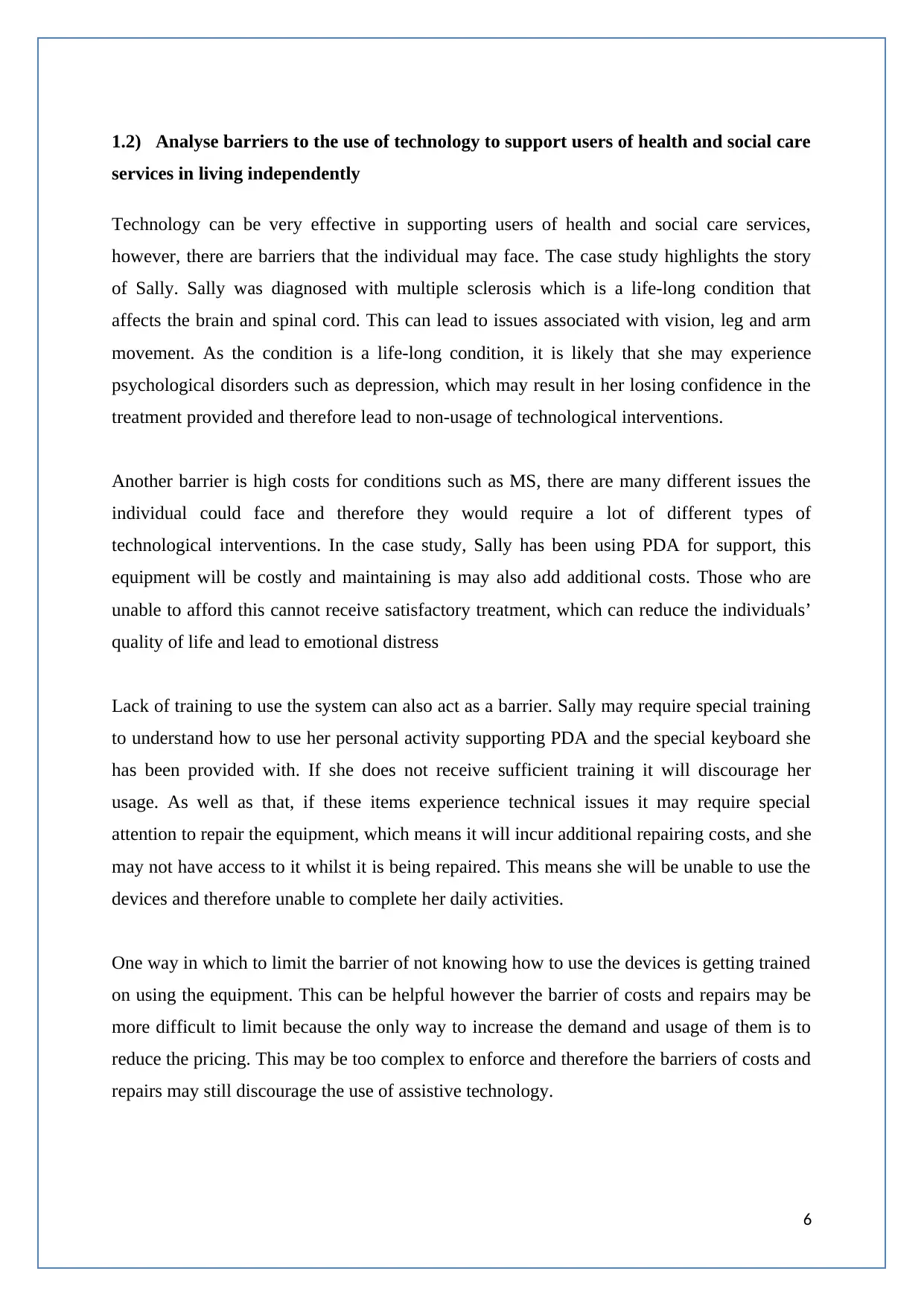
1.2) Analyse barriers to the use of technology to support users of health and social care
services in living independently
Technology can be very effective in supporting users of health and social care services,
however, there are barriers that the individual may face. The case study highlights the story
of Sally. Sally was diagnosed with multiple sclerosis which is a life-long condition that
affects the brain and spinal cord. This can lead to issues associated with vision, leg and arm
movement. As the condition is a life-long condition, it is likely that she may experience
psychological disorders such as depression, which may result in her losing confidence in the
treatment provided and therefore lead to non-usage of technological interventions.
Another barrier is high costs for conditions such as MS, there are many different issues the
individual could face and therefore they would require a lot of different types of
technological interventions. In the case study, Sally has been using PDA for support, this
equipment will be costly and maintaining is may also add additional costs. Those who are
unable to afford this cannot receive satisfactory treatment, which can reduce the individuals’
quality of life and lead to emotional distress
Lack of training to use the system can also act as a barrier. Sally may require special training
to understand how to use her personal activity supporting PDA and the special keyboard she
has been provided with. If she does not receive sufficient training it will discourage her
usage. As well as that, if these items experience technical issues it may require special
attention to repair the equipment, which means it will incur additional repairing costs, and she
may not have access to it whilst it is being repaired. This means she will be unable to use the
devices and therefore unable to complete her daily activities.
One way in which to limit the barrier of not knowing how to use the devices is getting trained
on using the equipment. This can be helpful however the barrier of costs and repairs may be
more difficult to limit because the only way to increase the demand and usage of them is to
reduce the pricing. This may be too complex to enforce and therefore the barriers of costs and
repairs may still discourage the use of assistive technology.
6
services in living independently
Technology can be very effective in supporting users of health and social care services,
however, there are barriers that the individual may face. The case study highlights the story
of Sally. Sally was diagnosed with multiple sclerosis which is a life-long condition that
affects the brain and spinal cord. This can lead to issues associated with vision, leg and arm
movement. As the condition is a life-long condition, it is likely that she may experience
psychological disorders such as depression, which may result in her losing confidence in the
treatment provided and therefore lead to non-usage of technological interventions.
Another barrier is high costs for conditions such as MS, there are many different issues the
individual could face and therefore they would require a lot of different types of
technological interventions. In the case study, Sally has been using PDA for support, this
equipment will be costly and maintaining is may also add additional costs. Those who are
unable to afford this cannot receive satisfactory treatment, which can reduce the individuals’
quality of life and lead to emotional distress
Lack of training to use the system can also act as a barrier. Sally may require special training
to understand how to use her personal activity supporting PDA and the special keyboard she
has been provided with. If she does not receive sufficient training it will discourage her
usage. As well as that, if these items experience technical issues it may require special
attention to repair the equipment, which means it will incur additional repairing costs, and she
may not have access to it whilst it is being repaired. This means she will be unable to use the
devices and therefore unable to complete her daily activities.
One way in which to limit the barrier of not knowing how to use the devices is getting trained
on using the equipment. This can be helpful however the barrier of costs and repairs may be
more difficult to limit because the only way to increase the demand and usage of them is to
reduce the pricing. This may be too complex to enforce and therefore the barriers of costs and
repairs may still discourage the use of assistive technology.
6
⊘ This is a preview!⊘
Do you want full access?
Subscribe today to unlock all pages.

Trusted by 1+ million students worldwide
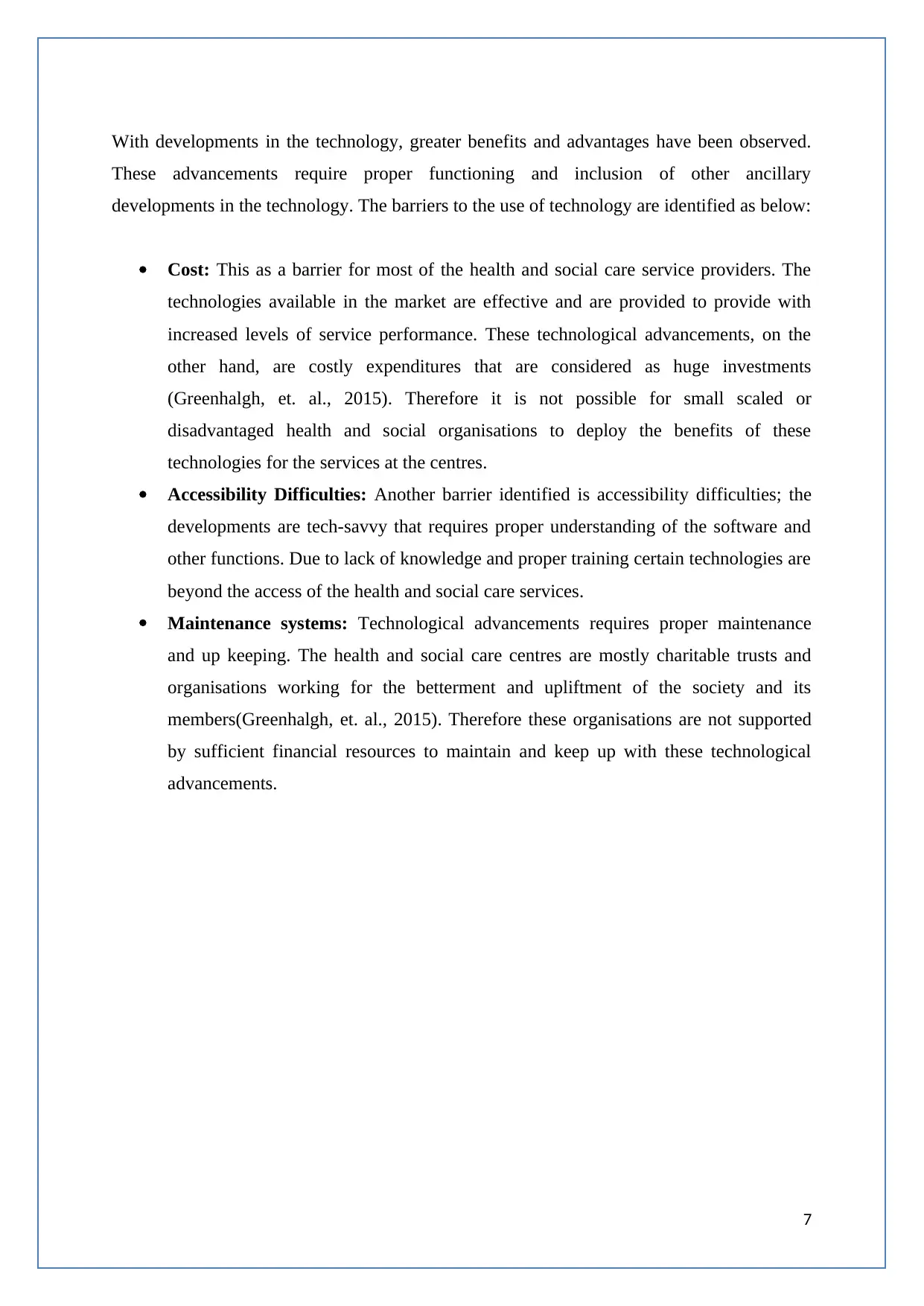
With developments in the technology, greater benefits and advantages have been observed.
These advancements require proper functioning and inclusion of other ancillary
developments in the technology. The barriers to the use of technology are identified as below:
Cost: This as a barrier for most of the health and social care service providers. The
technologies available in the market are effective and are provided to provide with
increased levels of service performance. These technological advancements, on the
other hand, are costly expenditures that are considered as huge investments
(Greenhalgh, et. al., 2015). Therefore it is not possible for small scaled or
disadvantaged health and social organisations to deploy the benefits of these
technologies for the services at the centres.
Accessibility Difficulties: Another barrier identified is accessibility difficulties; the
developments are tech-savvy that requires proper understanding of the software and
other functions. Due to lack of knowledge and proper training certain technologies are
beyond the access of the health and social care services.
Maintenance systems: Technological advancements requires proper maintenance
and up keeping. The health and social care centres are mostly charitable trusts and
organisations working for the betterment and upliftment of the society and its
members(Greenhalgh, et. al., 2015). Therefore these organisations are not supported
by sufficient financial resources to maintain and keep up with these technological
advancements.
7
These advancements require proper functioning and inclusion of other ancillary
developments in the technology. The barriers to the use of technology are identified as below:
Cost: This as a barrier for most of the health and social care service providers. The
technologies available in the market are effective and are provided to provide with
increased levels of service performance. These technological advancements, on the
other hand, are costly expenditures that are considered as huge investments
(Greenhalgh, et. al., 2015). Therefore it is not possible for small scaled or
disadvantaged health and social organisations to deploy the benefits of these
technologies for the services at the centres.
Accessibility Difficulties: Another barrier identified is accessibility difficulties; the
developments are tech-savvy that requires proper understanding of the software and
other functions. Due to lack of knowledge and proper training certain technologies are
beyond the access of the health and social care services.
Maintenance systems: Technological advancements requires proper maintenance
and up keeping. The health and social care centres are mostly charitable trusts and
organisations working for the betterment and upliftment of the society and its
members(Greenhalgh, et. al., 2015). Therefore these organisations are not supported
by sufficient financial resources to maintain and keep up with these technological
advancements.
7
Paraphrase This Document
Need a fresh take? Get an instant paraphrase of this document with our AI Paraphraser
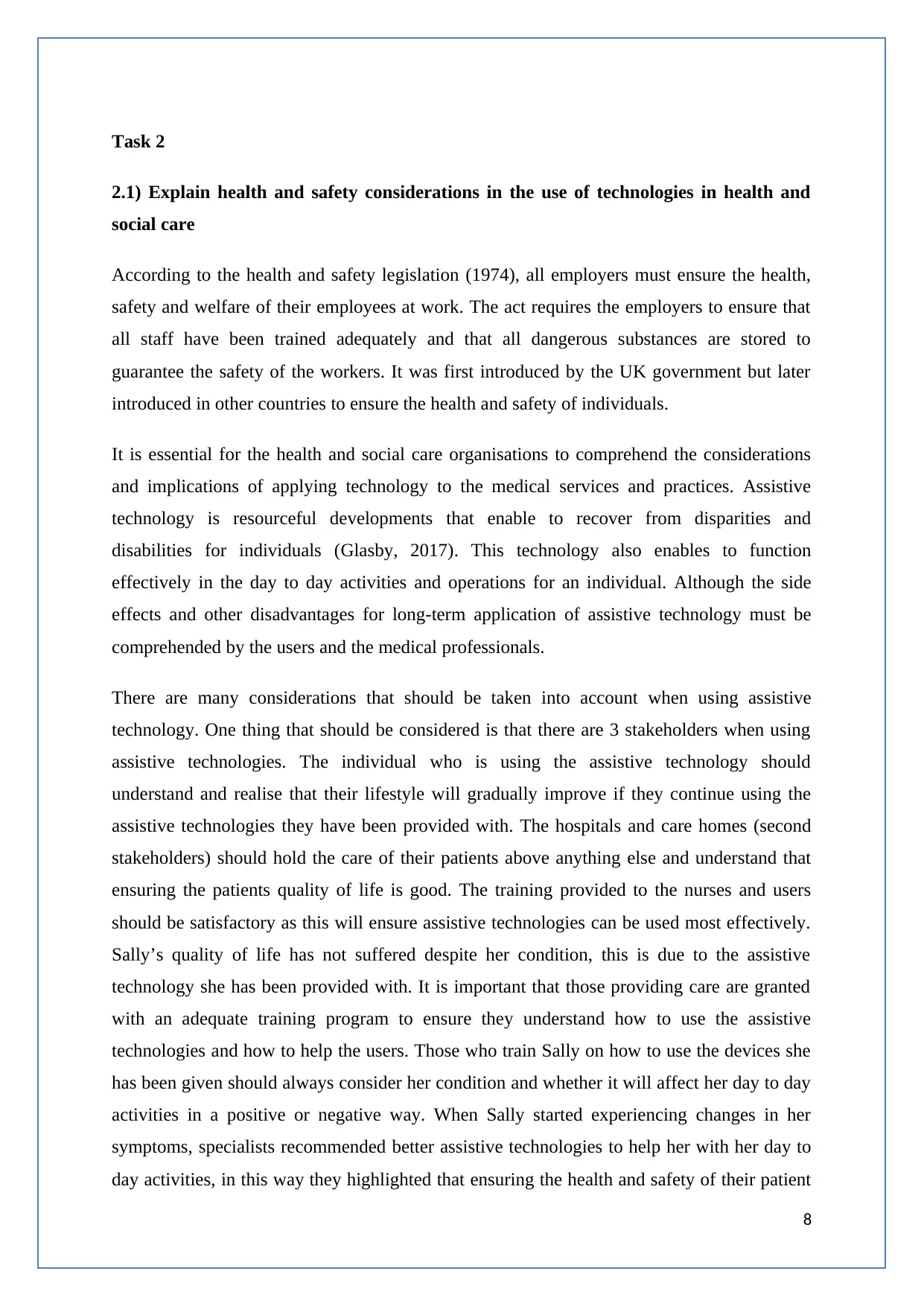
Task 2
2.1) Explain health and safety considerations in the use of technologies in health and
social care
According to the health and safety legislation (1974), all employers must ensure the health,
safety and welfare of their employees at work. The act requires the employers to ensure that
all staff have been trained adequately and that all dangerous substances are stored to
guarantee the safety of the workers. It was first introduced by the UK government but later
introduced in other countries to ensure the health and safety of individuals.
It is essential for the health and social care organisations to comprehend the considerations
and implications of applying technology to the medical services and practices. Assistive
technology is resourceful developments that enable to recover from disparities and
disabilities for individuals (Glasby, 2017). This technology also enables to function
effectively in the day to day activities and operations for an individual. Although the side
effects and other disadvantages for long-term application of assistive technology must be
comprehended by the users and the medical professionals.
There are many considerations that should be taken into account when using assistive
technology. One thing that should be considered is that there are 3 stakeholders when using
assistive technologies. The individual who is using the assistive technology should
understand and realise that their lifestyle will gradually improve if they continue using the
assistive technologies they have been provided with. The hospitals and care homes (second
stakeholders) should hold the care of their patients above anything else and understand that
ensuring the patients quality of life is good. The training provided to the nurses and users
should be satisfactory as this will ensure assistive technologies can be used most effectively.
Sally’s quality of life has not suffered despite her condition, this is due to the assistive
technology she has been provided with. It is important that those providing care are granted
with an adequate training program to ensure they understand how to use the assistive
technologies and how to help the users. Those who train Sally on how to use the devices she
has been given should always consider her condition and whether it will affect her day to day
activities in a positive or negative way. When Sally started experiencing changes in her
symptoms, specialists recommended better assistive technologies to help her with her day to
day activities, in this way they highlighted that ensuring the health and safety of their patient
8
2.1) Explain health and safety considerations in the use of technologies in health and
social care
According to the health and safety legislation (1974), all employers must ensure the health,
safety and welfare of their employees at work. The act requires the employers to ensure that
all staff have been trained adequately and that all dangerous substances are stored to
guarantee the safety of the workers. It was first introduced by the UK government but later
introduced in other countries to ensure the health and safety of individuals.
It is essential for the health and social care organisations to comprehend the considerations
and implications of applying technology to the medical services and practices. Assistive
technology is resourceful developments that enable to recover from disparities and
disabilities for individuals (Glasby, 2017). This technology also enables to function
effectively in the day to day activities and operations for an individual. Although the side
effects and other disadvantages for long-term application of assistive technology must be
comprehended by the users and the medical professionals.
There are many considerations that should be taken into account when using assistive
technology. One thing that should be considered is that there are 3 stakeholders when using
assistive technologies. The individual who is using the assistive technology should
understand and realise that their lifestyle will gradually improve if they continue using the
assistive technologies they have been provided with. The hospitals and care homes (second
stakeholders) should hold the care of their patients above anything else and understand that
ensuring the patients quality of life is good. The training provided to the nurses and users
should be satisfactory as this will ensure assistive technologies can be used most effectively.
Sally’s quality of life has not suffered despite her condition, this is due to the assistive
technology she has been provided with. It is important that those providing care are granted
with an adequate training program to ensure they understand how to use the assistive
technologies and how to help the users. Those who train Sally on how to use the devices she
has been given should always consider her condition and whether it will affect her day to day
activities in a positive or negative way. When Sally started experiencing changes in her
symptoms, specialists recommended better assistive technologies to help her with her day to
day activities, in this way they highlighted that ensuring the health and safety of their patient
8
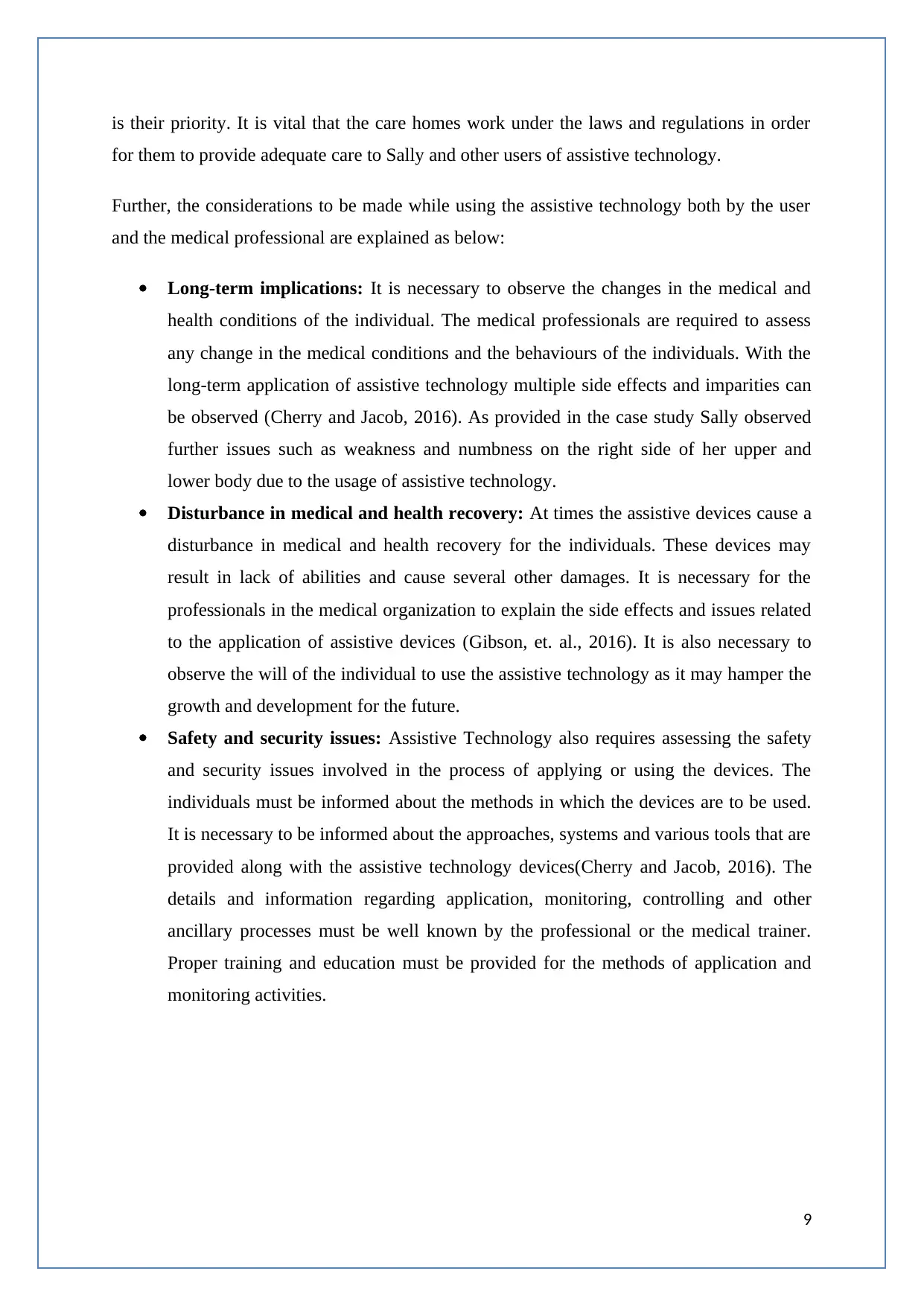
is their priority. It is vital that the care homes work under the laws and regulations in order
for them to provide adequate care to Sally and other users of assistive technology.
Further, the considerations to be made while using the assistive technology both by the user
and the medical professional are explained as below:
Long-term implications: It is necessary to observe the changes in the medical and
health conditions of the individual. The medical professionals are required to assess
any change in the medical conditions and the behaviours of the individuals. With the
long-term application of assistive technology multiple side effects and imparities can
be observed (Cherry and Jacob, 2016). As provided in the case study Sally observed
further issues such as weakness and numbness on the right side of her upper and
lower body due to the usage of assistive technology.
Disturbance in medical and health recovery: At times the assistive devices cause a
disturbance in medical and health recovery for the individuals. These devices may
result in lack of abilities and cause several other damages. It is necessary for the
professionals in the medical organization to explain the side effects and issues related
to the application of assistive devices (Gibson, et. al., 2016). It is also necessary to
observe the will of the individual to use the assistive technology as it may hamper the
growth and development for the future.
Safety and security issues: Assistive Technology also requires assessing the safety
and security issues involved in the process of applying or using the devices. The
individuals must be informed about the methods in which the devices are to be used.
It is necessary to be informed about the approaches, systems and various tools that are
provided along with the assistive technology devices(Cherry and Jacob, 2016). The
details and information regarding application, monitoring, controlling and other
ancillary processes must be well known by the professional or the medical trainer.
Proper training and education must be provided for the methods of application and
monitoring activities.
9
for them to provide adequate care to Sally and other users of assistive technology.
Further, the considerations to be made while using the assistive technology both by the user
and the medical professional are explained as below:
Long-term implications: It is necessary to observe the changes in the medical and
health conditions of the individual. The medical professionals are required to assess
any change in the medical conditions and the behaviours of the individuals. With the
long-term application of assistive technology multiple side effects and imparities can
be observed (Cherry and Jacob, 2016). As provided in the case study Sally observed
further issues such as weakness and numbness on the right side of her upper and
lower body due to the usage of assistive technology.
Disturbance in medical and health recovery: At times the assistive devices cause a
disturbance in medical and health recovery for the individuals. These devices may
result in lack of abilities and cause several other damages. It is necessary for the
professionals in the medical organization to explain the side effects and issues related
to the application of assistive devices (Gibson, et. al., 2016). It is also necessary to
observe the will of the individual to use the assistive technology as it may hamper the
growth and development for the future.
Safety and security issues: Assistive Technology also requires assessing the safety
and security issues involved in the process of applying or using the devices. The
individuals must be informed about the methods in which the devices are to be used.
It is necessary to be informed about the approaches, systems and various tools that are
provided along with the assistive technology devices(Cherry and Jacob, 2016). The
details and information regarding application, monitoring, controlling and other
ancillary processes must be well known by the professional or the medical trainer.
Proper training and education must be provided for the methods of application and
monitoring activities.
9
⊘ This is a preview!⊘
Do you want full access?
Subscribe today to unlock all pages.

Trusted by 1+ million students worldwide
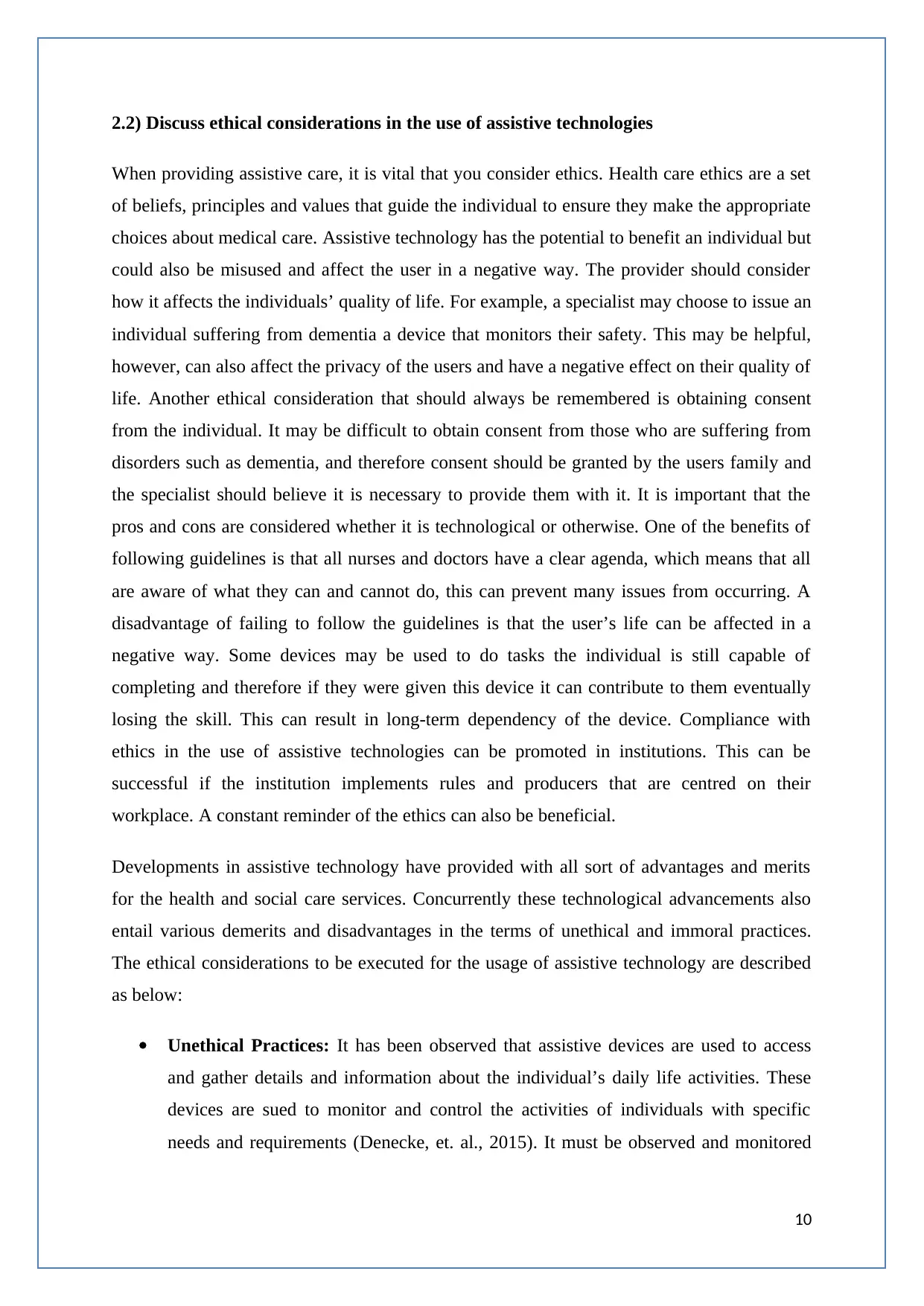
2.2) Discuss ethical considerations in the use of assistive technologies
When providing assistive care, it is vital that you consider ethics. Health care ethics are a set
of beliefs, principles and values that guide the individual to ensure they make the appropriate
choices about medical care. Assistive technology has the potential to benefit an individual but
could also be misused and affect the user in a negative way. The provider should consider
how it affects the individuals’ quality of life. For example, a specialist may choose to issue an
individual suffering from dementia a device that monitors their safety. This may be helpful,
however, can also affect the privacy of the users and have a negative effect on their quality of
life. Another ethical consideration that should always be remembered is obtaining consent
from the individual. It may be difficult to obtain consent from those who are suffering from
disorders such as dementia, and therefore consent should be granted by the users family and
the specialist should believe it is necessary to provide them with it. It is important that the
pros and cons are considered whether it is technological or otherwise. One of the benefits of
following guidelines is that all nurses and doctors have a clear agenda, which means that all
are aware of what they can and cannot do, this can prevent many issues from occurring. A
disadvantage of failing to follow the guidelines is that the user’s life can be affected in a
negative way. Some devices may be used to do tasks the individual is still capable of
completing and therefore if they were given this device it can contribute to them eventually
losing the skill. This can result in long-term dependency of the device. Compliance with
ethics in the use of assistive technologies can be promoted in institutions. This can be
successful if the institution implements rules and producers that are centred on their
workplace. A constant reminder of the ethics can also be beneficial.
Developments in assistive technology have provided with all sort of advantages and merits
for the health and social care services. Concurrently these technological advancements also
entail various demerits and disadvantages in the terms of unethical and immoral practices.
The ethical considerations to be executed for the usage of assistive technology are described
as below:
Unethical Practices: It has been observed that assistive devices are used to access
and gather details and information about the individual’s daily life activities. These
devices are sued to monitor and control the activities of individuals with specific
needs and requirements (Denecke, et. al., 2015). It must be observed and monitored
10
When providing assistive care, it is vital that you consider ethics. Health care ethics are a set
of beliefs, principles and values that guide the individual to ensure they make the appropriate
choices about medical care. Assistive technology has the potential to benefit an individual but
could also be misused and affect the user in a negative way. The provider should consider
how it affects the individuals’ quality of life. For example, a specialist may choose to issue an
individual suffering from dementia a device that monitors their safety. This may be helpful,
however, can also affect the privacy of the users and have a negative effect on their quality of
life. Another ethical consideration that should always be remembered is obtaining consent
from the individual. It may be difficult to obtain consent from those who are suffering from
disorders such as dementia, and therefore consent should be granted by the users family and
the specialist should believe it is necessary to provide them with it. It is important that the
pros and cons are considered whether it is technological or otherwise. One of the benefits of
following guidelines is that all nurses and doctors have a clear agenda, which means that all
are aware of what they can and cannot do, this can prevent many issues from occurring. A
disadvantage of failing to follow the guidelines is that the user’s life can be affected in a
negative way. Some devices may be used to do tasks the individual is still capable of
completing and therefore if they were given this device it can contribute to them eventually
losing the skill. This can result in long-term dependency of the device. Compliance with
ethics in the use of assistive technologies can be promoted in institutions. This can be
successful if the institution implements rules and producers that are centred on their
workplace. A constant reminder of the ethics can also be beneficial.
Developments in assistive technology have provided with all sort of advantages and merits
for the health and social care services. Concurrently these technological advancements also
entail various demerits and disadvantages in the terms of unethical and immoral practices.
The ethical considerations to be executed for the usage of assistive technology are described
as below:
Unethical Practices: It has been observed that assistive devices are used to access
and gather details and information about the individual’s daily life activities. These
devices are sued to monitor and control the activities of individuals with specific
needs and requirements (Denecke, et. al., 2015). It must be observed and monitored
10
Paraphrase This Document
Need a fresh take? Get an instant paraphrase of this document with our AI Paraphraser
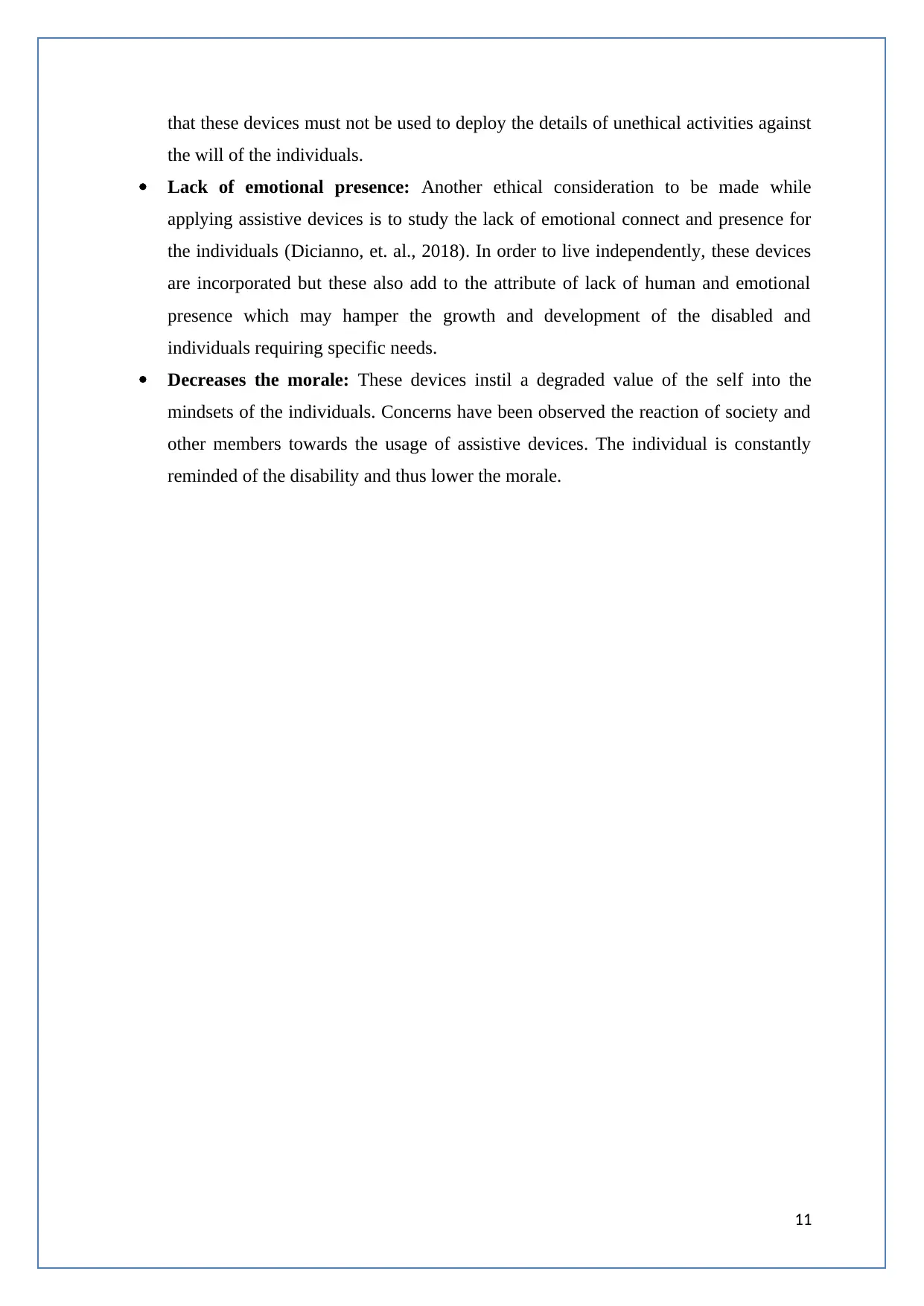
that these devices must not be used to deploy the details of unethical activities against
the will of the individuals.
Lack of emotional presence: Another ethical consideration to be made while
applying assistive devices is to study the lack of emotional connect and presence for
the individuals (Dicianno, et. al., 2018). In order to live independently, these devices
are incorporated but these also add to the attribute of lack of human and emotional
presence which may hamper the growth and development of the disabled and
individuals requiring specific needs.
Decreases the morale: These devices instil a degraded value of the self into the
mindsets of the individuals. Concerns have been observed the reaction of society and
other members towards the usage of assistive devices. The individual is constantly
reminded of the disability and thus lower the morale.
11
the will of the individuals.
Lack of emotional presence: Another ethical consideration to be made while
applying assistive devices is to study the lack of emotional connect and presence for
the individuals (Dicianno, et. al., 2018). In order to live independently, these devices
are incorporated but these also add to the attribute of lack of human and emotional
presence which may hamper the growth and development of the disabled and
individuals requiring specific needs.
Decreases the morale: These devices instil a degraded value of the self into the
mindsets of the individuals. Concerns have been observed the reaction of society and
other members towards the usage of assistive devices. The individual is constantly
reminded of the disability and thus lower the morale.
11
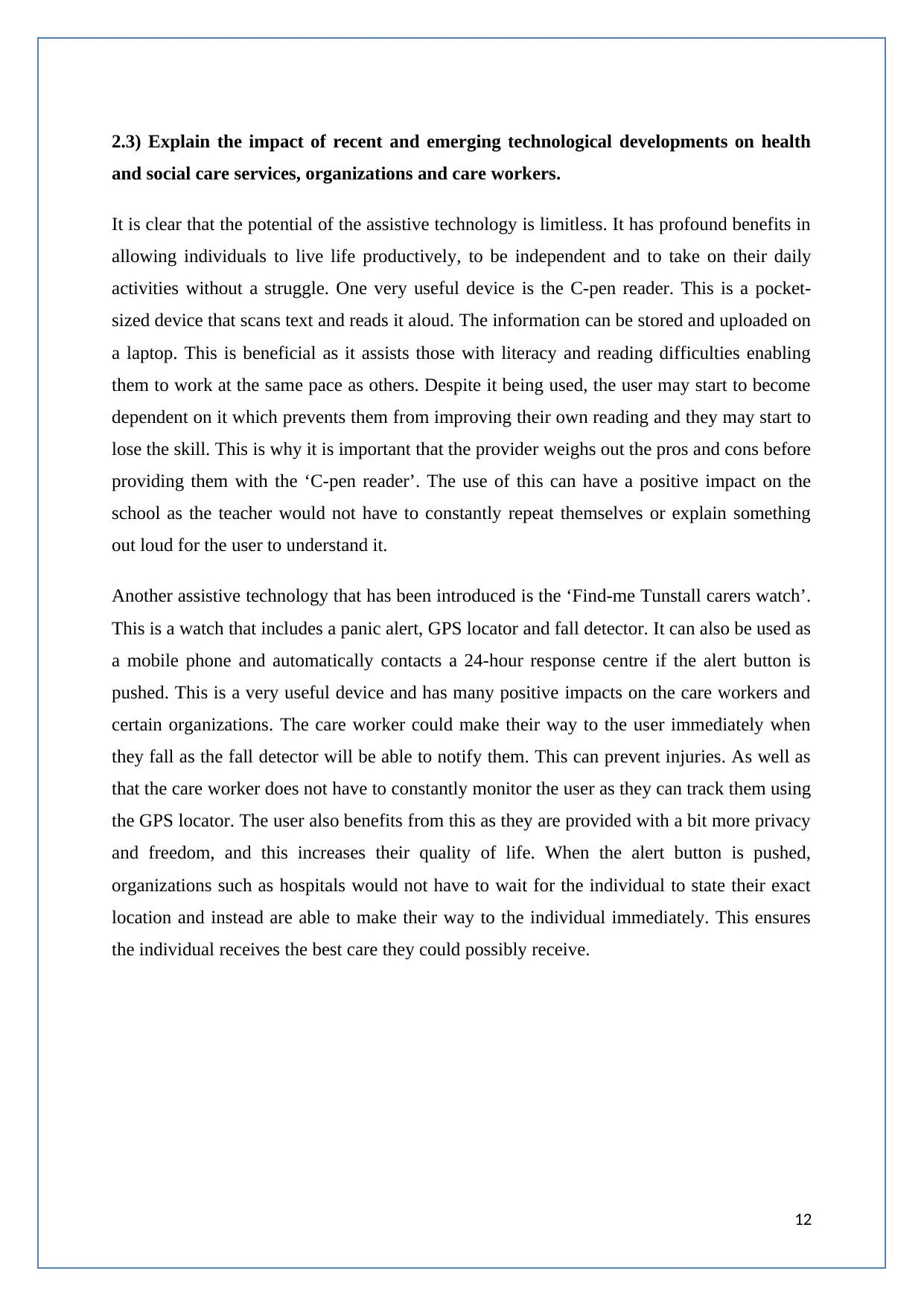
2.3) Explain the impact of recent and emerging technological developments on health
and social care services, organizations and care workers.
It is clear that the potential of the assistive technology is limitless. It has profound benefits in
allowing individuals to live life productively, to be independent and to take on their daily
activities without a struggle. One very useful device is the C-pen reader. This is a pocket-
sized device that scans text and reads it aloud. The information can be stored and uploaded on
a laptop. This is beneficial as it assists those with literacy and reading difficulties enabling
them to work at the same pace as others. Despite it being used, the user may start to become
dependent on it which prevents them from improving their own reading and they may start to
lose the skill. This is why it is important that the provider weighs out the pros and cons before
providing them with the ‘C-pen reader’. The use of this can have a positive impact on the
school as the teacher would not have to constantly repeat themselves or explain something
out loud for the user to understand it.
Another assistive technology that has been introduced is the ‘Find-me Tunstall carers watch’.
This is a watch that includes a panic alert, GPS locator and fall detector. It can also be used as
a mobile phone and automatically contacts a 24-hour response centre if the alert button is
pushed. This is a very useful device and has many positive impacts on the care workers and
certain organizations. The care worker could make their way to the user immediately when
they fall as the fall detector will be able to notify them. This can prevent injuries. As well as
that the care worker does not have to constantly monitor the user as they can track them using
the GPS locator. The user also benefits from this as they are provided with a bit more privacy
and freedom, and this increases their quality of life. When the alert button is pushed,
organizations such as hospitals would not have to wait for the individual to state their exact
location and instead are able to make their way to the individual immediately. This ensures
the individual receives the best care they could possibly receive.
12
and social care services, organizations and care workers.
It is clear that the potential of the assistive technology is limitless. It has profound benefits in
allowing individuals to live life productively, to be independent and to take on their daily
activities without a struggle. One very useful device is the C-pen reader. This is a pocket-
sized device that scans text and reads it aloud. The information can be stored and uploaded on
a laptop. This is beneficial as it assists those with literacy and reading difficulties enabling
them to work at the same pace as others. Despite it being used, the user may start to become
dependent on it which prevents them from improving their own reading and they may start to
lose the skill. This is why it is important that the provider weighs out the pros and cons before
providing them with the ‘C-pen reader’. The use of this can have a positive impact on the
school as the teacher would not have to constantly repeat themselves or explain something
out loud for the user to understand it.
Another assistive technology that has been introduced is the ‘Find-me Tunstall carers watch’.
This is a watch that includes a panic alert, GPS locator and fall detector. It can also be used as
a mobile phone and automatically contacts a 24-hour response centre if the alert button is
pushed. This is a very useful device and has many positive impacts on the care workers and
certain organizations. The care worker could make their way to the user immediately when
they fall as the fall detector will be able to notify them. This can prevent injuries. As well as
that the care worker does not have to constantly monitor the user as they can track them using
the GPS locator. The user also benefits from this as they are provided with a bit more privacy
and freedom, and this increases their quality of life. When the alert button is pushed,
organizations such as hospitals would not have to wait for the individual to state their exact
location and instead are able to make their way to the individual immediately. This ensures
the individual receives the best care they could possibly receive.
12
⊘ This is a preview!⊘
Do you want full access?
Subscribe today to unlock all pages.

Trusted by 1+ million students worldwide
1 out of 20
Related Documents
Your All-in-One AI-Powered Toolkit for Academic Success.
+13062052269
info@desklib.com
Available 24*7 on WhatsApp / Email
![[object Object]](/_next/static/media/star-bottom.7253800d.svg)
Unlock your academic potential
Copyright © 2020–2025 A2Z Services. All Rights Reserved. Developed and managed by ZUCOL.





